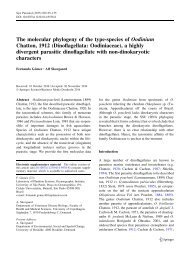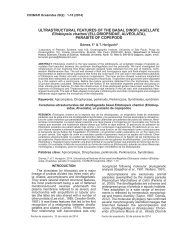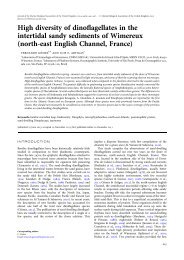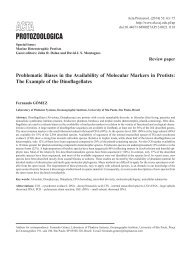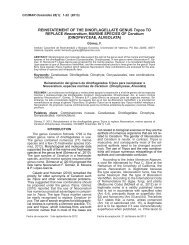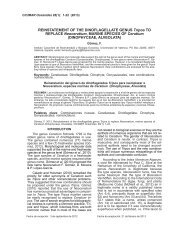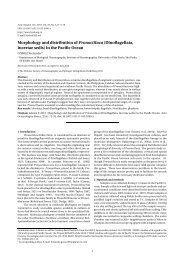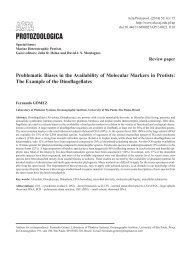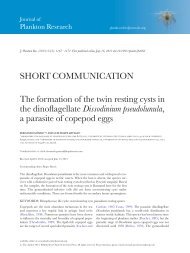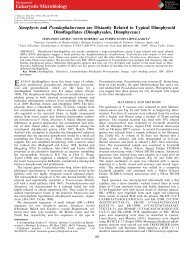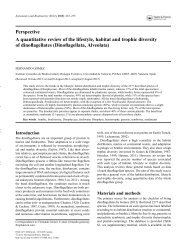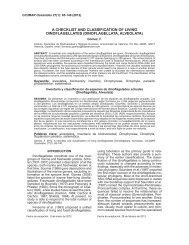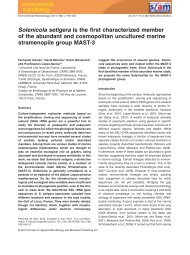Molecular Phylogeny of the Parasitic Dinoflagellate Chytriodinium within the Gymnodinium Clade (Gymnodiniales, Dinophyceae)
The dinoflagellate genus Chytriodinium, an ectoparasite of copepod eggs, is reported for the first time in the North and South Atlantic Oceans. We provide the first large subunit rDNA (LSU rDNA) and Internal Transcribed Spacer 1 (ITS1) sequences, which were identical in both hemispheres for the Atlantic Chytriodinium sp. The first complete small subunit ribosomal DNA (SSU rDNA) of the Atlantic Chytriodinium sp. suggests that the specimens belong to an undescribed species. This is the first evidence of the split of the Gymnodinium clade: one for the parasitic forms of Chytriodiniaceae (Chytriodinium, Dissodinium), and other clade for the free-living species.
The dinoflagellate genus Chytriodinium, an ectoparasite of copepod eggs, is
reported for the first time in the North and South Atlantic Oceans. We provide
the first large subunit rDNA (LSU rDNA) and Internal Transcribed Spacer 1
(ITS1) sequences, which were identical in both hemispheres for the Atlantic
Chytriodinium sp. The first complete small subunit ribosomal DNA (SSU rDNA)
of the Atlantic Chytriodinium sp. suggests that the specimens belong to an
undescribed species. This is the first evidence of the split of the Gymnodinium
clade: one for the parasitic forms of Chytriodiniaceae (Chytriodinium, Dissodinium),
and other clade for the free-living species.
Create successful ePaper yourself
Turn your PDF publications into a flip-book with our unique Google optimized e-Paper software.
Gomez & Skovgaard<br />
<strong>Phylogeny</strong> <strong>of</strong> <strong>Parasitic</strong> <strong>Chytriodinium</strong> in <strong>Gymnodinium</strong> <strong>Clade</strong><br />
Figure 1 <strong>Phylogeny</strong> tree inferred from <strong>the</strong> SSU rDNA sequences using Bayesian inference method. The species newly sequenced in this study<br />
are bold. Accession numbers are provided. Posterior probability <strong>of</strong> 1 is denoted with a black circle; white circles denote posterior probability <strong>of</strong><br />
0.95–0.99. ML bootstrap support (when above 50%) is given near nodes. The scale bar represents <strong>the</strong> number <strong>of</strong> substitutions per site. Numbers<br />
at <strong>the</strong> end <strong>of</strong> each taxon name are GenBank accession numbers.<br />
morphology <strong>of</strong> <strong>the</strong> dinospores <strong>of</strong> <strong>the</strong> Mediterranean <strong>Chytriodinium</strong><br />
affine has not been examined in detail in order to<br />
establish differences with o<strong>the</strong>r tentative species. No obvious<br />
differences exist between <strong>the</strong> Mediterranean <strong>Chytriodinium</strong><br />
affine and <strong>Chytriodinium</strong> sp. from <strong>the</strong> tropical<br />
Atlantic Ocean. The size, shape and general appearance<br />
<strong>of</strong> <strong>the</strong> infective spores <strong>of</strong> <strong>the</strong> Mediterranean and Atlantic<br />
species is similar. The life cycle and appearance <strong>of</strong> <strong>the</strong><br />
© 2014 The Author(s) Journal <strong>of</strong> Eukaryotic Microbiology © 2014 International Society <strong>of</strong> Protistologists<br />
Journal <strong>of</strong> Eukaryotic Microbiology 2014, 0, 1–4 3



